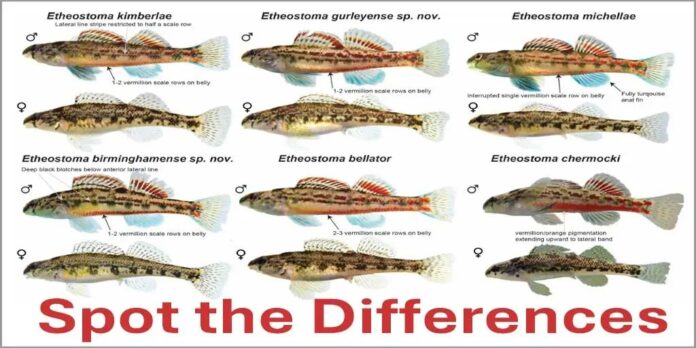Opinion by Kip Hansen
Way down in Bessemer, Alabama, the development of a huge data center is being fought with a time-tried and proven tactic : invent a new species of the darter-fish and declare it at once “endangered”. According to locals and environmental activists the new development would certainly spell doom for the little discovered-just-in-time new darter – this one declared to be the “Birmingham darter” or Etheostoma birminghamense.
A team of biologists headed by Chase D. Brownstein at Yale University determined the new species “using genomic analyses.” and counting “the numbers of scale rows and fin elements from each specimen and performed principal component analysis (PCA) of the meristic traits…” Of course, there were many differences between the individual fish of these “meristic traits” so the authors classified them into “new” species based on average values for those counted traits, in some cases using mean values, in other the modal number.
Yet, the definition of “meristic traits” is generally this:
“Meristic traits are characteristics of organisms that can be counted and are expressed as whole numbers. These traits are discrete, meaning they have distinct, countable categories rather than a continuous range of values. Examples include the number of fins, scales, or vertebrae in an organism.”

The terminology used in the table is “average number of lateral line spines”, “modal number of first dorsal fine spines” and the “mean value of genealogical divergence index”.
These are not simple counts, though two are presented as whole numbers (allowed by the use of the mode, instead of the mean). These fish, claimed as distinct species, all have between 46 and 49 lateral line scales (individuals in each species having differing counts around the average). Each of the new species consists of fish with dorsal fin spines equally varied around 10 or 11, and the same for pectoral fin rays, around 13 or 14.
In this we find the fine art of the Species Splitters, a term:
“…introduced more widely by George G. Simpson in his 1945 work The Principles of Classification and a Classification of Mammals. As he put it:
“splitters make very small units – their critics say that if they can tell two animals apart, they place them in different genera … and if they cannot tell them apart, they place them in different species. … Lumpers make large units – their critics say that if a carnivore is neither a dog nor a bear, they call it a cat.” [ wiki ]
Minor differences number of scales and fin elements, that vary from individual-to-individual as well as between very localized and somewhat isolated populations seem to have been exaggerated in importance to create new species.
None of these newly declared species have been official designated as “Endangered Species”, but the paper, Brownstein et al. [2025], labels them “imperiled”.
Purposefully invented imperiled species? Who can say? …but certainly convenient to the anti-development activists in Alabama.
# # # # #
Author’s Comment:
Successful ploys are always tried again and again. The famous snail darter was used to delay the building of the Tellico Dam for years. We can look forward to the anti-data-center activists in Alabama using The Science [purpose?] produced by Brownstein et al. to attempt to stop or delay approvals for construction.
As is almost always true, activists are not interested in the new Birmingham Darter – they just want to stop the building of the data center. Same old same old.
Thanks for reading.
# # # # #
Related
Discover more from Watts Up With That?
Subscribe to get the latest posts sent to your email.





